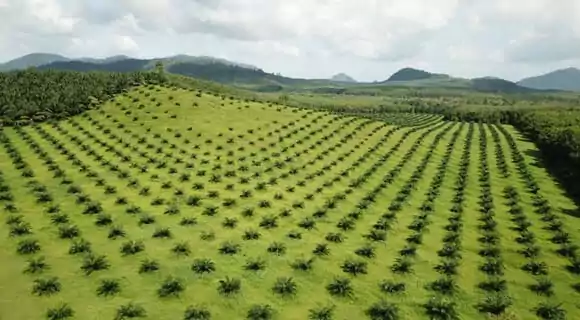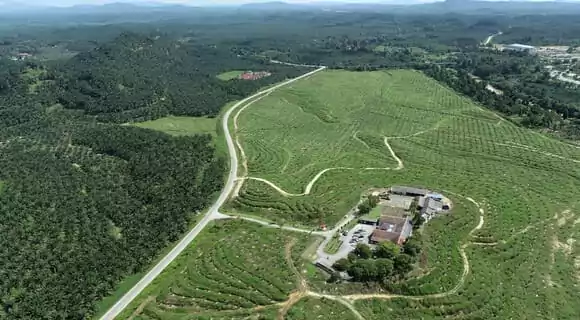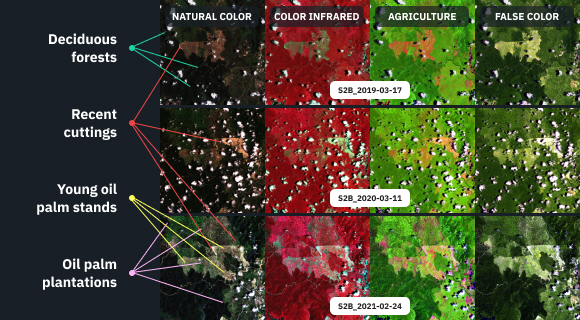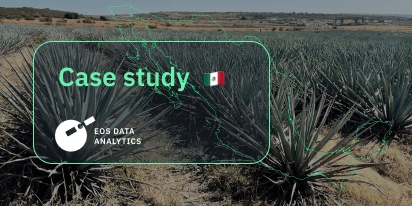
Palm Oil Deforestation: Adverse Effects & Ways to Stop
Palm oil is included in versatile products, from hygiene items to biofuel or food. However, the ingredient is notorious for the palm oil deforestation issue, apart from its affordability. Sadly, palm oil and deforestation closely relate. Its growing consumption increases demand, which aggravates the situation even more. The palm oil deforestation map covers the rainforests of Latin America, West Africa, and Southeast Asia, bringing negative consequences for tropical wildlife and our planet in general. Deforestation for palm oil is no reasonable solution, though, and commodity producers should switch to more sustainable methods instead.
How Does Palm Oil Contribute To Deforestation?
Various satellite imagery sources reveal severe forest losses globally, many of which are connected to deforestation due to palm oil production. Just to illustrate it with figures, the market demand in 2019 made 74.6 million tons, with an expected rise of 2.3% by 2027 . Consequently, this rise involves land grabbing and deforestation for palm oil, making the greatest impact on rainforest areas.
The reason for the product’s popularity is its increased use for food, from baby formulas to snacks. The benefits of this ingredient are disputable. Even though palm oil is 50% saturated fats, increasing cholesterol levels and heart disease risks, it is still trans-fat free and has less saturated fat, say, than butter. Considering that the product is cheap, it is an obvious choice for many. In fact, the commodity has penetrated our lives through shampoo, toothpaste, detergent, medications, chocolate, cookies, ice cream, soap, and whatnot. This is not necessarily bad. The bad thing is that palm oil contributes to deforestation.

Does All Palm Oil Contribute To Deforestation?
Fortunately not. The rate of deforestation for palm oil gradually slows down , thanks to governmental control, ecologic NGO activities, law enforcement, public awareness, ethical concerns, producers’ and consumers’ responsibility, and merely common sense. Thus, the compliance of oil palm fruit production with voluntary sustainability standards (VSS) in 2016 made 17.4% globally . It may seem not really much compared to 82.2% of the conventional one. However, accounted that it had been 100% conventional until 2013, the achievement was great.
Ideally, palm oil without deforestation is possible. The Roundtable on Sustainable Palm Oil (RSPO) was created in 2004 to advocate the eco-friendly approach and revert the process of deforestation for palm oil. As a result, major consumer goods manufacturers like Colgate-Palmolive, P&G, Nestle, Ferrero, Pepsico Inc., Unilever, and others pledged to use fully sustainable (zero deforestation) sources by 2022. RSPO Annual Communication of Progress (ACOP) of 2019 reports up to 100% transition to certified products. It also uncovers certain failures to meet the 2020 deadlines for NDPE commitments (no deforestation, no peat, no exploitation). In particular, some big companies show the following results: Bayer – 100%, Unilever – 99.56%, Colgate-Palmolive – 61.95%, to mention a few. Still, only 19% of the commodity has been RSPO-certified globally by now.

Adverse Effects Of Palm Oil Deforestation
Technically, some trees are cut to grow others, but it’s in no way reforestation. Palms do contribute to air purification, yet rainforest deforestation due to palm oil production would be but a lame excuse.
Here are some of the most severe negative effects of deforestation for palm oil production. Thus, deforestation:
- Endangers thousands of rainforest species by destroying their natural habitat for the sake of plantations, which drastically impacts biodiversity. Indeed, Indonesian forests house 10% of the world’s unique fauna species , as of the 2014 report of the Ministry of Environment and Forestry in Indonesia.
- Deprives indigenous peoples of their native lands, where they had lived for centuries until they lost their land rights because of expanding palm oil plantations in Southeast Asia and were displaced.
- Contributes to global warming by increasing GHG emissions due to carbon release, particularly, after slash-and-burn practices. In addition, choking fumes of burning forests poison people and nature.
- Increases risks of flooding and landslides because trees make a natural barrier to water flows, and newly planted ones need time to grow.
- Reduces soil health. Trees hold the earth in place with their strong root systems, but the nutrient-rich top layer is easily washed away after their removal, which is adverse to soil fertility. Besides, palm oil deforestation leads not only to soil depletion but soil erosion and sedimentation as well.
- Adds to water pollution. Washed-off soil particles and other contaminants leak off to water bodies.

How Palm Oil Mills Affect Expansion Of Plantations
Palm oil production is favorable for economic development and employment, particularly, in rural areas. However, stakeholders often try to run their businesses nearly at maximum, striving for the highest ROIs. Palm oil mill owners are no exception. Logically, the more their mills process, the more raw materials they need.
However, greediness hardly accords sustainability. In this case, it is often among the causes of palm oil deforestation, which prevents consumer goods manufacturers from meeting the NDPE requirements. This is why companies are to check their supply chains and exclude the compromising deforestation links. They can achieve the goal with good governance and proper expertise.
EOSDA To Monitor Deforestation Due To Palm Oil Production
Obviously, huge enterprises can’t inspect thousands of their global suppliers in place. However, here is what they can:
- monitor supply chains remotely thanks to geospatial technologies;
- identify possible deforestation and palm oil connections through spatial analysis;
- conveniently visualize the results with GIS mapping.
Alongside that, detecting deforestation events around mills de facto is not the only use of satellite monitoring. It also allows assessing the risks of a potential effect of palm oil production on deforestation. Thus, it is possible to correlate mill capacity with nearby plantation productivity that can be estimated with historical and current satellite images. If nearby plantation productivity is lower than mill capacity, the shortfall may cause forest cuts for plantation expansion. So, such mills require acute attention.
Besides, satellite monitoring suggests near real-time alerts to all business stakeholders to look deeper into the situation whenever necessary. Big manufacturers can turn to free satellite imagery sources or invest in partnerships with tech companies to be in the know by deploying monitoring systems around their mills.
EOSDA offers satellite monitoring systems of forest cover with its EOSDA LandViewer and upcoming product for forestry needs. The infographics below illustrate the possibility to detect deciduous forests, forest cuts, newly planted trees, and oil palm plantations.

The images are based on the following band combinations:
- Natural color is similar to human perception, so vibrant vegetation is green; unhealthy plants are yellowish or brownish.
- Color infrared (vegetation) distinguishes plants in the hues of red, while lighter hues are for bushes and grasses. Brown or dark red is assigned to conifer forests, which look darker compared to deciduous ones.
- Agriculture bands show vegetation in green.
- False color features vegetation in darker to lighter greens.
With the platform EOSDA LandViewer, detecting deforested areas becomes even easier. Select an AOI and monitor any changes in forest canopy continuously.
Sustainable Palm Oil Production
It is clear that with increasing commodity demand, plantation areas will also expand. However, to comply with sustainability and no-deforestation requirements, it should be done in a way that is alternative to deforestation. Thus, sustainable forestry solutions to palm oil deforestation suggest locating plantations only on agricultural and fallow lands, not at the cost of forest cuts. This approach will eliminate the adverse environmental effects of the devastating practice.
The goal implementation requires close collaboration of all stakeholders, including authorities and regular citizens. With a sole demand for the certified, deforestation-free product and an eradicated use of the deforestation-involved one, the situation will drastically improve.
Satellite monitoring of both certified and non-certified sources facilitates a successful outcome of the palm oil rainforest deforestation issue, among the many more capabilities of data-driven analytics.
About the author:
Petro Kogut has a PhD in Physics and Mathematics and is the author of multiple scientific publications. He is the Soros Associated Professor as well as the head of the department of differential equations in the Oles Honchar Dnipro National University and has received a number of grants, prizes, honorary decorations, medals, and other awards. Prof. Dr. Petro Kogut is a science advisor for EOSDA.
Recent articles

Digital Tools Improve Soil Health And Yields In Mexico
EOSDA and ITTA supported a Guanajuato farm with contour-line planning, monitoring tools, and practical guidance to reduce soil erosion and improve yields in the long run.

Analyze 2025 & Plan Your Best Year Yet: LandViewer Christmas Offer
It’s the most wonderful time of the year! The Christmas holidays are here, and so is your chance to analyze 2025 and plan a prosperous 2026 with more affordable Pro plans in LandViewer.

EOSDA Models Climate Change Impact On Sugarcane Yields
EOSDA modeled future temperature, rainfall, and other climate impacts on Veracruz sugarcane. The results help growers plan long-term adaptation strategies, including timing, varieties, and irrigation.